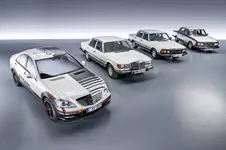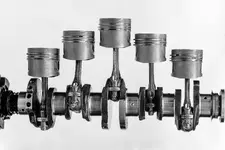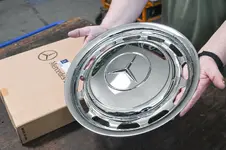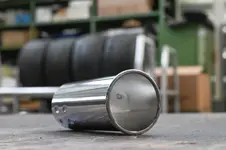#mercedesbenz #mercedes #daimlerbenz #daimler #germancarforum
- 1949: Hanover Export Fair with new models from Daimler-Benz AG
- 1974: Mercedes-Benz experimental safety vehicle ESF 24
- 1974: Mercedes-Benz 240 D 3.0 – The world’s first passenger car with a five-cylinder diesel engine
- 1974: Foundation of the Mercedes-Benz Club of South Australia
- Important service: Mercedes-Benz Classic Genuine Parts
- Mercedes-Benz Classic Magazine 1/2024 celebrates passion and the 300 SL
Mercedes-Benz, the world’s oldest car manufacturer, has been reinventing the car over and over since 1886. As it does so, the brand continually sets new standards, while also keeping pace with social change. The history of the company is correspondingly rich in events and stories. Here is a brief summary of some of the important anniversaries and milestones from its history.
20 to 30 May 1949 – 75 years ago
Debut of the Mercedes-Benz 170 D and 170 S (W 136 model series) at the Hanover Export Fair
- A spirit of optimism in front of an international audience
- 170 D as the highly acclaimed first Mercedes-Benz diesel passenger car of the post-war period
- The luxurious 170 S was also available as a two-seater and four-seater convertible
A spirit of optimism prevailed at Mercedes-Benz 75 years ago: at the Technical Export Fair in Hanover, the German automotive industry was able to present itself to an international audience in its own country for the first time since the end of the Second World War. Two new passenger cars were on display. Both belonged to the W 136 model series. The 170 D in particular was a sensation. The four-door model had the smallest diesel engine ever in a production vehicle at the time and immediately aroused enthusiasm in the relevant specialised media. The second new model, the 170 S, had a more spacious body and offered separately adjustable ventilation of the passenger compartment on both sides as standard. Heating was available at an extra charge. A new front axle design contributed to the comfortable and safe driving behaviour of the 170 S. The top Mercedes-Benz model at the time was also offered as a Cabriolet B and as a particularly luxurious Cabriolet A. The great importance of all new models became clear against the backdrop of the economic situation at the time: the “economic miracle” of the young Federal Republic was only vaguely recognisable in 1949. Supply restrictions for electricity and coal as well as production bottlenecks for iron and petrol rationing were still determining the pace of the upturn.
4 June 1974 – 50 years ago
The ESF 24 experimental safety vehicle was presented in London
- Highlight of the Mercedes-Benz ESF programme in the 1970s
- Contribution to automotive safety research based on the S-Class 116 model series
- Design solutions for a frontal impact as the main focus
With 35 experimental safety vehicles (ESF models), Mercedes-Benz researched automotive safety systems in the 1970s as part of the international ESV programme and put them on the road to series production. Daimler-Benz presented the ESF 24 at the 5th International ESV Conference in London (4 to 7 June 1974). This vehicle, based on the S-Class of the 116 model series, focused on researching designs for a frontal impact with a rigid barrier at 65 km/h (40 mph). In 1974, Mercedes-Benz emphasised in a press release that the ESF 24 could not be regarded as a prototype for future series vehicles due to its greater length and its approximately ten per cent greater weight and the corresponding increase in fuel consumption in view of the growing scarcity of raw materials and energy. Head of Research Professor Hans Scherenberg drew this conclusion at the time: the realisation that “a period of intensive basic research must now be initiated to ensure that further advances in safety technology are based on realistic, economic grounds” were valuable.
12 July 1974 – 50 years ago
Premiere of the first five-cylinder diesel engine passenger car in the 240 D 3.0 “Stroke Eight”
- The world’s most powerful diesel passenger car to date had an output of 59 kW (80 hp)
- Technically closely related to the four-cylinder 240 D model
- The suffix “/8” was added to all new models in 1968
The Mercedes-Benz 240 D 3.0 with the 59 kW/80 hp three-litre five-cylinder OM 617 engine is one of the sought-after representatives of the “Stroke Eight” model series 114 and 115, production of which started in 1968. On 12 July 1974, 50 years ago, the 240 D 3.0 was presented in Frankfurt/Main and Hockenheim. The mid-size saloon of the E-Class tradition was the most powerful diesel passenger car and also the world’s first five-cylinder series-produced passenger car. The engine had the same stroke-bore ratio and the same cylinder spacing as the four-cylinder engine of the 240 D with 48 kW/65 hp. From 1974 to 1976, 53,690 units of the 240 D 3.0 were produced. The OM 617 continued to be built in the 300 D of the 123 model series until 1985. The term “Stroke Eight”, which is commonly used in classic car circles today, was created due to the addition of “/8” in internal Mercedes-Benz publications for all models released in 1968. However, the abbreviation is only used for the 114 and 115 model series in classic car parlance.
15 July 1974 – 50 years ago
18 Mercedes-Benz fans founded the Mercedes-Benz Club of South Australia
- Diverse commitment for a lively club life
- 80 officially recognised Mercedes-Benz brand clubs worldwide with around 100,000 members
- Promoting and enhancing the shared enjoyment of owning a Mercedes-Benz
The primary aim of the Mercedes-Benz Club of South Australia is to promote and enhance the enjoyment of owning a Mercedes-Benz. This has been happening with like-minded people for 50 years now. In early 1974, Reverend Clem Minge placed an advert in the Adelaide local newspaper “The Advertiser” inviting people to form a Mercedes-Benz brand club. On 30 June 1974, eleven Mercedes-Benz drivers and their cars accepted the invitation. The second meeting on 15 July 1974 was attended by 18 fans of the brand. Now the club was born, and Clem Minge was elected president. For 50 years, the club has been involved in classic car events, visits to local workshops and car collections, and participation in national rallies. The club, based in Edwardstown near Adelaide in South Australia, has long been officially recognised by Mercedes-Benz as a brand club. It is now one of some 80 Mercedes-Benz clubs and communities with approximately 130,000 members worldwide. Every club lives the enthusiasm and passion for mobility, the community and the exchange of expertise among its members. 65 years ago, in 1959, the first passenger car had already rolled off the production line of the Mercedes-Benz assembly plant in Melbourne, an hour and a half flight east of Adelaide. It was a 220 S (W 180).
Mercedes-Benz Classic Genuine Parts
Keeping the brand’s classics ready for use in authentic condition
- Replacement parts for 170 D, 170 S and 240 D 3.0
- The trend is rising sharply: 160,000 parts for 57 model series
- 20,000 Mercedes stars are sold every year
Whether Mercedes-Benz 170 D, 170 S or 240 D 3.0 – Mercedes-Benz Classic Genuine Parts provides an extensive range of replacement parts for these and many other classic vehicles, as only a manufacturer can offer. These replacement parts and wear parts stand for the highest quality and originality down to the last detail, and also boast short delivery times. The replacement parts service helps to keep the brand’s classics in authentic condition over the long term. Some popular parts for the models presented in this newsletter: for the 170 D and 170 S of the 136 model series, for example, there are original hub caps (Part Number A 136 401 06 25, price: EUR 252.16). For the “Stroke Eight” models, the genuine parts range from the hub cap (Part Number A 115 401 03 24, price: EUR 453.65), the gear knob for the early version of the automatic gearstick (Part Number A 113 267 00 10, price: EUR 65.16) and the exhaust tailpipe (Part Number A 123 492 07 14, price: EUR 142.23) to the repair kit for the Mercedes star (Part Number A 115 586 04 88, price: EUR 131.71) and the gear indicator for the automatic transmission (Part Number A 114 270 03 52, price: EUR 395.79). All prices quoted are recommended retail prices for Germany and include 19 per cent VAT. Mercedes-Benz Classic supplies a total of 160,000 parts for 57 model series in 170 countries. Of the Mercedes stars alone, Mercedes-Benz Classic has 42 different versions on offer and sells almost 20,000 of them every year. Link:
https://teilesuche.mercedes-benz-classic.com.
Mercedes-Benz Classic Magazine 1/2024
Passion for Mercedes-Benz as the comprehensive theme of the issue
“Passion” is the comprehensive theme of the new Mercedes-Benz Classic Magazine. Axel and Maureen Schröter’s 220 SE “Ponton” Coupé (W 128) on the cover photo is a perfect match. Just like the Mercedes-Benz 300 SL “Gullwing” (W 198), which is staged on a photo art track together with the SLS AMG. The club story picks up on a road trip through the US State of Oregon. And an article on the technology of the 300 SL, which also looks at the SLS AMG, goes into detail. This actually happened recently: a Mercedes-Benz Type SS Sport four-seater (W 06) rolled through Stuttgart’s still empty streets three hours after midnight. The latest issue of the Mercedes-Benz Classic Magazine, which has been released on 10 May 2024, shows photos as proof, along with an accompanying text. This issue features many more articles with exciting stories and extraordinary pictures from Monaco and Portugal, among other places. The Mercedes-Benz Classic Centre in Fellbach also has a new look after a good 30 years. And the Jupiter’s Flash Rally in Italy stretches over 2,500 kilometres from the Dolomites to the very south of Sicily. Media representatives can read and download the latest Mercedes-Benz Classic Magazine issue online at
media.mercedes-benz.com/magazine.
Mercedes-Benz Media











